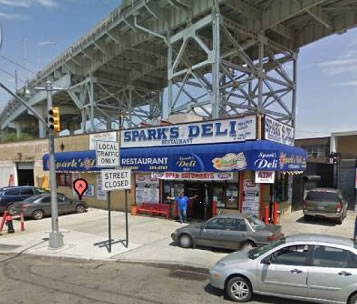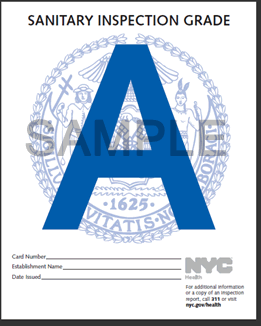 Health Commissioner Thomas Farley Awards Spark's Deli of Long Island City the Health Department's First A Grade for Sanitary Conditions
Health Commissioner Thomas Farley Awards Spark's Deli of Long Island City the Health Department's First A Grade for Sanitary Conditions
New restaurant grading system and expanded website give consumers ready access to information about eating establishments' food safety practices

Photo: Google Maps
The Health Department launched New York City's new restaurant grading system Wednesday morning, awarding the first A grade to a well-kept deli in Long Island City. Health Commissioner Dr. Thomas Farley presented the grade to owners Jose and Antonio Araujo, congratulating them for performing so well on an unannounced sanitary inspection. He heralded the luncheonette as a model for the city's 24,000 other eating establishments. "Whether it's a neighborhood deli or a pricey dinner house, any food establishment can prepare food safely," he said. "Sparks has set an example."
"We're proud to see this A in our window," Jose Araujo said. "Our inspection reports have been online for years, but now we can share the good news with anyone passing on the street. This sign says we care about cleanliness, and we care about our customers' safety."
The new initiative - designed to raise public awareness of sanitary conditions and encourage best practices by restaurant operators - requires all establishments to post A, B or C letter grades near entrances following sanitary inspections. The new system also concentrates City resources on those that pose the greatest risk to public health by inspecting them more often. The initiative, long championed by State Senator Jeffrey Klein, was approved by the City's Board of Health in March. Health Department sanitarians conducted the first graded inspections on Tuesday.
To complement the posting of grades at restaurants, the City also unveiled a revamped website that makes it easier for consumers to find detailed, up-to-date inspection results for any of the city's 24,000 eating establishments. The site's search tool can sort eateries by name, borough, neighborhood, ZIP code, cuisine type or inspection score. It can also search by multiple criteria at once (for example, A-grade Italian restaurants in Williamsburg, Brooklyn with fewer than 14 inspection violation points). The site provides maps and addresses for restaurants, and it includes a downloadable widget that can be placed on other websites to enable visitors to directly search for restaurants. The enhanced site also enables restaurant owners to settle fines with the City through an online tool developed by the Department of Information Technology and Telecommunications.

Under the new initiative, restaurants with A grades will be inspected annually, but those receiving lower marks will get more frequent visits. A restaurant receiving 0 to13 violation points on an initial inspection will receive a grade of A, which must be posted immediately. Restaurants with more points will get a chance to improve their scores on a re-inspection conducted a short time later. Those scoring 14 to 27 points on the re-inspection will get a B, and those with 28 or more will receive a C. The Health Department will continue to close establishments that pose immediate health risks, and the City will inspect restaurants with B or C grades more often than those receiving A's. Besides focusing City resources on the establishments that need more monitoring, this risk-based inspection cycle will give low-performing restaurants frequent opportunities to achieve higher grades. If a restaurant wants to contest violations, it can post a "Grading Pending" sign until it has had a chance to be heard at a Health Department hearing.
"Most restaurants maintain good conditions, but lapses in food safety cause a lot of preventable illness in New York City," said Commissioner Farley. "Food-borne illness prompts thousands of hospital visits each year, and it costs many New Yorkers valuable days of work or school. By putting information about inspection results on public display, we give diners the information they want while also encouraging restaurants to improve their food preparation practices. This will be good for the health of New Yorkers and - as restaurant operators improve their practices - good for the restaurant industry too."
Research from other jurisdictions shows that public posting of inspection findings has improved business, reduced food-borne illness and improved overall sanitary inspections for restaurants. When the City of Los Angeles adopted a grading system in 1998, for example, only 40 percent of restaurants received an A grade. One year later, it rose to more than 70 percent, and within four years, to more than 80 percent.
The City is also working on many fronts to help restaurant operators prepare for the new grading system and make inspections easier for inspectors and owners. Besides mailing detailed information to all affected establishments, and posting it online, the Health Department is holding multi-lingual workshops in all five boroughs to explain procedures and answer questions. More than 2,500 restaurant operators, kitchen workers and staff have attended these trainings to date. To learn more about restaurant grading, please visit nyc.gov/health .
###
